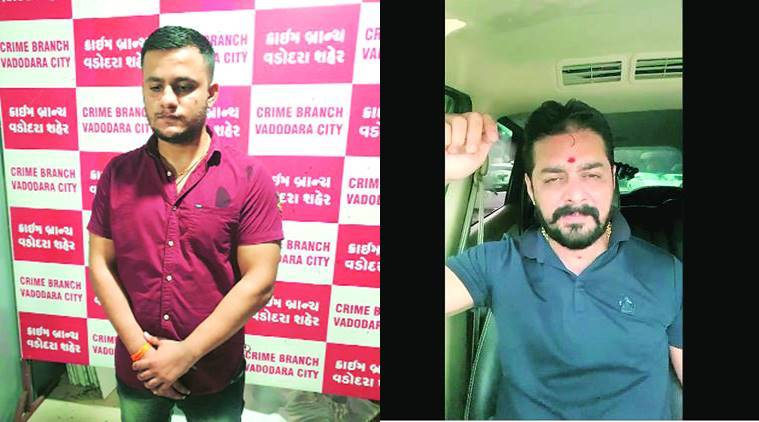 Shubham Mishra (L), Vikas Fhatak.
Shubham Mishra (L), Vikas Fhatak.
Shubham Mishra, arrested by the Vadodara police earlier this month for uploading a video abusing and issuing rape threats to stand-up comic Agrima Joshua, reportedly told the Gujarat Police that he was hoping for an invitation to a popular reality TV show hosted by actor Salman Khan.
Mishra, who has around 3 lakh followers on his YouTube channel, was only following in the abuse-filled, trailblazing path of his mentor in Mumbai, Vikas Fhatak alias Hindustani Bhau. With over 3.3 million followers hanging on every abuse in the videos on his Instagram, Fhatak was in 2019 invited to Big Boss season 13 as a contestant.
In the quest for celebrity, youth such as Fhatak and Mishra believe they have stumbled upon an unbeatable success mantra – targeted abuse on social media, especially against women or against a country such as Pakistan, attracts fans like iron filings to a magnet. And that brings fame, and money.
As the number of followers increase, such social media accounts begin attracting advertisement revenues. No other qualifications are required, so long as they unflinchingly pour abuse — which includes rape threats — into their social media feeds.
Not just this, Fhatak and his ilk also seem confident they can get away with it. With the high number of social media accounts with abusive content raking in a high number of followers, usually, unless an account is repeatedly reported to the authorities or if there is some police action, the platforms generally ignore the type of content.
The police too act in cases where someone gives a complaint and the act falls under the Indian Penal Code or Information Technology Act. In the absence of these safeguards, some of these popular social media accounts get away posting toxic content without any pushback and rake in views.
“It all started after the Pulwama attacks of February 2019, following which there were around 50 Pakistani YouTubers who would abuse Indian Army in their videos. I started countering their videos and abused them. Now only two are left,” Fhatak said.
Dr M T Joseph, assistant professor at Department of Sociology, Mumbai University, said: “Cultural nationalism has so much following that people who want to become famous would portray their messaging in such a manner that they fall in that category.”
An officer from the Maharashtra Cyber Police said that generally, the cases into which they have managed to register FIRs pertain to posts targeting women. “Recently, we took action against a tiktoker who put up a video that promoted acid attacks on women. Likewise, if there are any rape threat or obscene content posted against any woman and she approaches us or tags us on social media, we take necessary action.”
Fhatak, who lives in a fishermen’s colony in Khar, said he always records his videos sitting in his car as as he is “shy” to do it in front of others. Fhatak said he has not monetised his account that he claims to use “only to serve the country”. His manager said he does brand promotions on his videos but the money goes to charity.
On platforms like YouTube, social media accounts with a huge fan following reel in ads, in addition to product placement during the video for which the brand pays them. Popular YouTubers are known to earn large sums.
“Social media primarily runs on advertising that requires sensational content. The creators also get a share of the ad spend and exclusive brand partnership. Hence, for both, the platform and the creator, the number of views and analytics is definitely more important than the content,” said Apar Gupta, executive director of Indian Freedom Foundation, an organisation that works towards keeping Internet free and open, describing such content as “created by Gen Z for Gen Z”.
A YouTube spokesperson said, “We have strict policies prohibiting harassment on YouTube, and terminate any channel that repeatedly or egregiously violates those policies, in accordance with our strike system.”
But that does not seem to act as a deterrent, and the followers are part of the problem, according to some. Jitendra Sharma or ‘TedTheStoner’ on Instagram, who has 1.4 million followers, was one of the first to share the video abusing Joshua, asking the police to take action against Shubham Mishra.
Sharma said it was perhaps back in 2015 that social media users realised that using cuss words in posts gets a lot of engagement.”Hence, you cannot only blame the content creator for this toxic culture,”
“Mainstream media too has created a lot of hate content and in this atmosphere, even if you sit in your vehicle and abuse Pakistan for 15 minutes without having anything worthwhile to say, people are becoming famous. The fact that such people are invited to reality TV shows that audiences want that. It is our fault that we put such people on a pedestal and when they suddenly go from abusing Pakistan to putting up rape threats, there is shock,” he added.
A top YouTuber, Ajey Nagar, whose handle ‘CarryMinati’ with 23.9 million subscribers also has abusive content, in one of his latest video titled “the art of bad words” — it had received over 2.33 crore hits — gives out the reason why abuses form such an important part of the “Gen Z” videos.
“On a stage, some words are dancing and the audience is happy seeing them. Suddenly, an abuse enters the stage and other words disappear… some people are happy seeing the abuse… some are angry… but there is no doubt that everyone is only looking at the abuse,” he said.